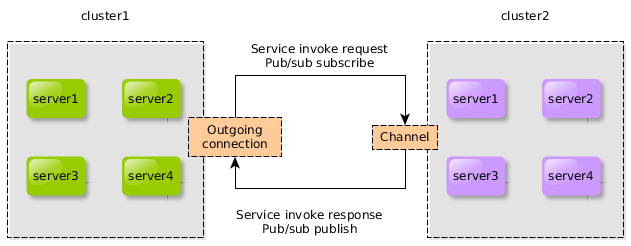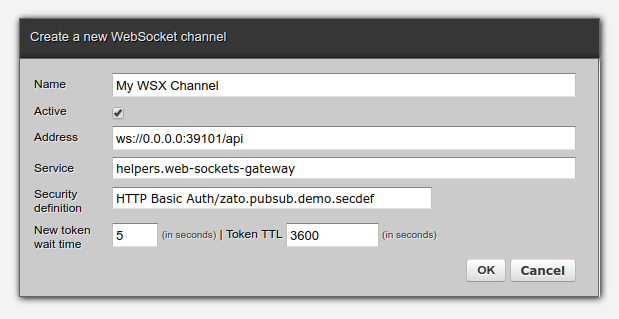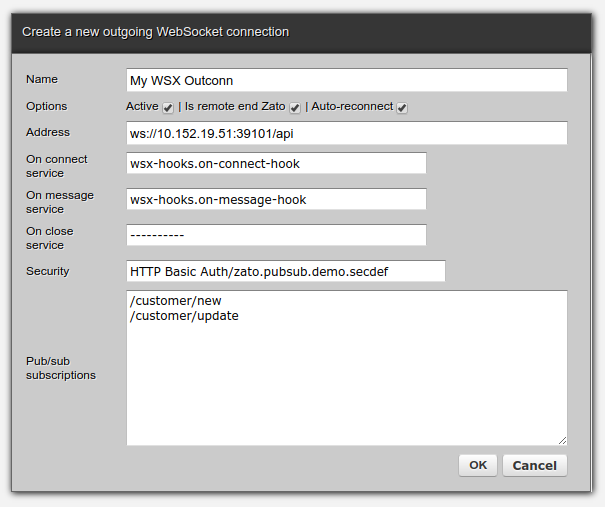Connecting Zato clusters with WebSockets
Since version 3.0, it is possible to directly connect Zato clusters and exchange messages as though remote services where running in a local instance. This makes it an ideal choice for environments split into multiple parts.
Introduction
The reasons to have more than one cluster, each with one or more servers, may vary:
- For HA and performance, environments may be broken out geographically into a setup with one cluster per continent or a region of the world
- CPU-extensive operations may be carried out in one cluster with another making use of the results the former produces to offer a set of APIs
- For legal reasons, it may not be allowed to run all integration services in one cluster, using the same hardware and software infrastructure
The new feature in Zato 3.0 which allows for efficient communication between clusters are WebSocket connections - one of clusters will create a channel through with other clusters may invoke its services via their outgoing connections.
WebSockets (WSX for short) have essentially no overhead in practice but they can be used for bi-directional communication hence they are a great choice for such scenarios.
From a Zato programmer's perspective, all the communication details are hidden and a couple of lines of code suffices to invoke services or receive messages from remote clusters, for instance:
# Obtain a handle to a remote connection
with self.out.wsx.get('My Connection').conn.client() as client:
# Invoke a remote service - expects a Python dict on input
# and returns a Python dict on response. All the serialization
# and network connectivity is handled automatically.
response = client.invoke(msg)
Architecture and configuration

Each cluster which is to become a recipient of messages from other clusters needs to have a new WebSocket channel created with service helpers.web-sockets-gateway mounted on it. A security definition should also be attached as required.
Each cluster that should invoke another one needs to have an outgoing WebSocket connection created - make sure Is remote end Zato checkbox is on and that credentials are provided, if required by the other side.
If the cluster with an outgoing connection is interested in receiving publish/subscribe messages, all topics it wants to subscribe to should be listed, one in each line. Make sure the cluster with a channel has a correct pub/sub endpoint configured for that channel.
The cluster which establishes the connection (here, cluster1) may also want to subscribe to events of interest via hooks services - more about it below.
Once an outgoing connection is created, internal tasks will start on cluster1 to establish a remote connection to server2. If successful, authentication will take place automatically. Finally, if configured, a hook service will fire to let cluster1 know that a new connection was established. Afterwards, cluster1 may start to invoke remote services.
There are no other steps involved, at this point everything is configured and ready to be used.


From a programmer's perspective
- To invoke remote Zato services, programmers use WebSockets outgoing connections methods - providing a dictionary of input data to the invocation and receiving a dictionary of data on input. Note that the invocation is synchronous, your service is blocked until the remote cluster responds.
# -*- coding: utf-8 -*-
from zato.server.service import Service
class MyService(Service):
def handle(self):
# Message to send - needs to be a dictionary with name
# of the service to invoke as well as its input data, if any is required.
# In this case, we are invoking an echo service
# which writes back to output anything it receives on input.
msg = {
'service':'zato.helpers.echo',
'request': {
'elem1': 'value1',
'elem2': 'value2',
}
}
# Name of the connection to send messages through
conn_name = 'My WSX Outconn'
# Obtain a client from the connection pool
with self.out.wsx.get(conn_name).conn.client() as client:
# Send the message and read its response
response = client.send(msg)
# Or, client.invoke can be used with Zato WebSocket connections,
# this method is an alias to client.send
response = client.invoke(msg)
# Log the response received
self.logger.info('Response is `%s`', response.data)
To receive messages, hook services are used. There are three events for which hooks can be triggered - they can be handled by different services or the same one, it is up to users:
Upon connecting to a remote cluster, including reconnects (on_connect)
- Upon receiving messages from remote clusters (on_message)
Once a connection to the remote cluster is shut down (on_close)
The on_message hook can be combined with publish/subscribe topics and queues - each time the remote cluster (the one with a WSX channel) publishes a message that the local cluster (the one with a WSX outgoing connection) is interested in, the on_message hook will be called to handle it, in this manner making it possible for remote clusters to deliver messages to clusters subscribing to topics.
Each hook is just a Zato service with a specific SimpleIO signature, as in the on_message example below:
# -*- coding: utf-8 -*-
from zato.server.service import Opaque, Service
class OnMessageHook(Service):
class SimpleIO:
input_optional = (Opaque('ctx'),)
def handle(self):
# Object describing incoming data
ctx = self.request.input.ctx
# Message type
msg_type = ctx.type
# Data received
data = ctx.data
# Log message type
self.logger.info('Msg type: `%s`', msg_type)
# Log actual data
self.logger.info('Data received: `%s`', data.data)
# Log metadata - ID and timestamp
self.logger.info('Meta: `%s` `%s`', data.id, data.timestamp)
Now, we can use web-admin to publish a test message and confirm that the on_message service receives it:

In the on_message service's server logs:
INFO - Msg type: `message`
INFO - Data received: `[
{u'delivery_count': 0,
u'msg_id': u'zpsme26726911ffbe8cba2cca278',
u'expiration_time_iso': u'2086-09-21T14:03:05.285470',
u'topic_name': u'/customer/new',
u'pub_time_iso': u'2018-09-03T10:48:58.285470',
u'priority': 5,
u'expiration': 2147483647000,
u'has_gd': True,
u'data': u'This is a sample message',
u'sub_key': u'zpsk.websockets.6ef529f7cab64a71d8bd2878',
u'mime_type': u'text/plain',
u'size': 24}
]`
INFO - `6fd296ecf78493a3a0ce7570` `2018-09-03T10:49:00.540024`
Summary
- In Zato 3.0 and later clusters can be easily connected using efficient WebSocket connections
- Once configured, such connections are maintained automatically under the hood
- Connections can be used either to invoke remote services or to receive messages from publish/subscribe topics and queues in a straightforward manner
- As always, the focus of the new functionality is to let users concentrate on their actual integration needs rather than on tedious, low-level, details
